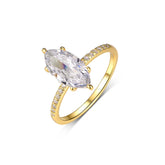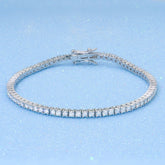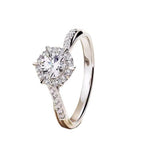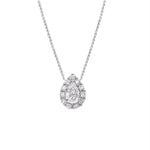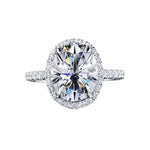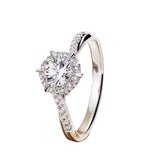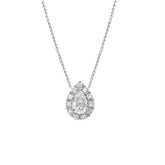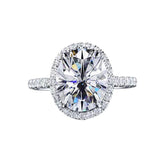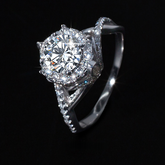What Is Moissanite — And Why More People Are Choosing It
What Is Moissanite — And Why More People Are Choosing It
Moissanite is a lab-created gemstone made of silicon carbide (SiC). It delivers dazzling fire, excellent everyday durability, and a larger look for your budget — which is why you’re seeing it everywhere from daily studs to engagement rings.
- What it is: Silicon carbide (SiC), typically lab-grown for jewelry.
- Sparkle stats: Refractive index 2.648–2.691; dispersion (fire) 0.104; Mohs hardness ~9.25.
- Origin story: First identified in 1893 by Dr. Henri Moissan in a meteorite crater in Arizona; jewelry-grade stones are lab-grown.
- Why people pick it: Bigger visual size per dollar, rainbow-like fire, durable daily wear, and a lab-created supply chain.
1) Definition & Key Properties
Moissanite is silicon carbide (SiC). In fine jewelry, virtually all moissanite is lab-created. Its optical and physical constants explain the “wow” effect under real-life lighting.
| Property | Moissanite | Diamond (for reference) |
|---|---|---|
| Refractive Index (RI) | 2.648–2.691 | 2.417–2.419 |
| Dispersion (Fire) | 0.104 | 0.044 |
| Mohs Hardness | ~9.25 | 10 |
“Moissanite has a higher refractive index and dispersion than diamonds, resulting in greater brilliance and more colorful fire.” Source: jewelry education resources & gemological literature
“Discovered by Dr. Henri Moissan in 1893 in a meteorite crater in Arizona; nearly all jewelry-grade moissanite is lab-created.” Source: gem society & museum references
2) Why More People Are Buying Moissanite
① A bigger, brighter look for your budget
At the same visual size, moissanite often costs a fraction of natural diamond prices, freeing budget for a larger center stone or a premium setting. Its higher dispersion (~0.104) produces that signature rainbow fire in restaurant, sunset, and evening lighting.
② A lab-created supply chain
Jewelry-grade moissanite is grown in controlled labs. For many shoppers, this simplifies provenance and avoids traditional mining steps.
③ Durable daily wear
With hardness around 9.25 on the Mohs scale, moissanite resists scratches in day-to-day life and stays lively with simple home cleaning.
Shop the Looks at Verse & Hue Jewelry
Verse & Hue Jewelry designs everyday-fine pieces that move from coffee to cocktails — plus bridal silhouettes when you’re ready to say yes.
- Prologue — minimalist essentials (think 6.5 mm moissanite studs, slim bands, clean pendants). Explore Prologue
- Gala — camera-ready sparkle (S925 moissanite tennis bracelets in 2–6 mm for instant presence). Explore Gala
- Bridal — engagement and anniversary rings (18K oval-cut solitaires, halos, and custom sizes). Explore Bridal
Tip: For maximum fire in photos, try oval, cushion, or pear cuts at 1 ct+; for subtle everyday sparkle, a 0.5–1 ct round in a simple four- or six-prong setting is perfect. For wrists, 2–3 mm tennis bracelets look clean; 4–5 mm reads bold on camera.
3) Moissanite vs. Diamond — Quick Facts You Can Quote
- Brilliance & fire: Higher RI and dispersion give moissanite lively white brilliance and prismatic fire.
- Durability: Diamond is the hardest known gemstone (10), but moissanite (~9.25) is more than tough enough for everyday wear.
- Value: Moissanite enables larger center stones and design flexibility at a friendlier price point.
- Origin: Diamonds can be mined or lab-grown; moissanite for jewelry is lab-grown.
4) When to Choose Moissanite
- You want a larger look and high-impact sparkle within a specific budget.
- You prefer a lab-created option with streamlined provenance.
- You need a low-maintenance daily or travel ring and worry less about loss.
- You love modern cuts and custom sizing without price anxiety.
5) Care & Testing Notes
- Clean with mild dish soap and a soft brush, or use a household ultrasonic as directed by your jeweler.
- Avoid harsh chemicals and hard knocks on tiles or metal edges.
- Some single-function “diamond testers” can misread moissanite; professional labs confirm identity using multiple optical tests.
6) Quick Answers
What is moissanite?
A lab-created gemstone of silicon carbide (SiC) with high brilliance (RI ~2.65–2.69), strong fire (dispersion ~0.104), and everyday-ready durability (Mohs ~9.25).
Why are more people buying it?
Because it offers a bigger look per dollar, colorful fire, durable daily wear, and a lab-created origin — all while matching modern tastes for minimalist, wearable luxury.
References & Further Reading
- GIA — Synthetic Moissanite: A New Diamond Substitute (optical constants & historical context). gia.edu
- American Gem Society — Moissanite overview and history. americangemsociety.org
- Brilliant Earth — Moissanite education (RI/dispersion comparisons). brilliantearth.com
- The Knot — Cost comparisons for diamond vs. moissanite (example price ranges). theknot.com
- Industry coverage on lab-grown adoption (market acceptance backdrop). axios.com
Figures are representative and vary with cut quality, color/clarity grades, brand, and market conditions.



